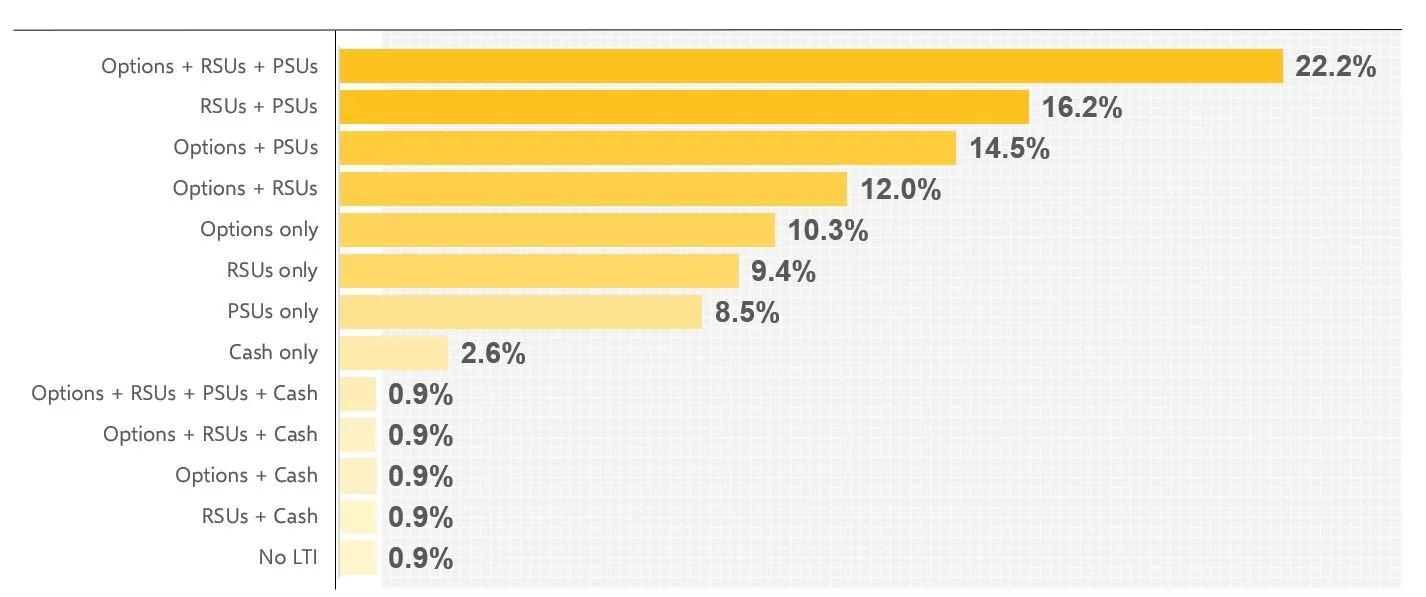Long-Term Incentive Plan Designs in the Canadian Mid-Market
Executive Compensation Trends in the TSX Mid-Cap
Compensation Governance Partners aims to provide you with up-to-date executive compensation information and trends, via our proprietary compensation database (composed of fully evaluated and sized named executives from publicly-traded organizations).
In this series of articles, we will cover executive compensation practices and trends from the 2019 proxy season for the top 5 paid executives from each company in the TSX 100-200*. We will also highlight year-over-year changes in both compensation and policy compared to the 2018 proxy season.
Typically, publicly-traded organizations will use share-based awards or option-based awards to deliver long-term incentives (LTI) to encourage equity ownership among executives and provide greater potential upside than a straightforward cash plan. Providing executives with equity ownership in the organization also aligns the executives’ compensation with shareholders’ returns.
The most prevalent LTI vehicles among the TSX mid-cap are used in very similar proportions: stock options (used by 61.5 percent of organizations), time-based (“restricted”) share units (62.4 percent), and performance-based share units (62.4 percent). These numbers are down slightly from last year as cash-based plans showed a slight increase in usage. A small number of organizations use long-term cash or provide no LTI.
Types of Long-term Incentive Vehicles
Figure 1: Prevalence of LTI vehicles in the Canadian mid-market
Stock Options
A stock option is the right to buy the underlying stock at a specific price in the future as stated by the option. Options provide a more leveraged payout if the underlying stock over-performs, allowing for higher potential upside than other LTI vehicles. Stock options have historically been tax-advantageous over other LTI vehicles, but proposed new limitations on the preferential tax treatment of options may result in a gradual shift away from options among larger TSX issuers.
Restricted Share Unit
A restricted share unit (RSU) is a share unit that has a time-based condition, with no performance requirements for the executives. RSUs can be settled in either cash or shares.
Performance Share Unit
A performance share unit (PSU) is a share unit that has a performance condition attached, with the intention that certain targets be achieved by the end of the performance period. The final number of PSUs received will vary based on the achievement of the performance conditions. PSUs can be settled in either cash or shares.
Long-Term Cash
Long-term cash awards are awards with a performance condition attached, similar to performance share units, but are settled in cash.
Long-term Incentive Conditions
Other conditions are also added to these LTI vehicles, depending on the desired effect:
Term
Stock options have a term which refers to the length of time after grant during which the option can be exercised. For example, an option that was awarded in January 2015 and expires in January 2020 has a term of 5 years. Terms for stock options typically range from 5 to 10 years. The term for RSUs and PSUs is typically 3 years.
Vesting Period
The vesting period of an LTI award refers the amount of time that the award must be held before it can be sold or exercised. An LTI award may vest either on a ratable / gradual basis (e.g. a third of the award vests every anniversary from the grant date), or on a cliff basis (e.g. the award completely vests on the third anniversary of the grant date). Vesting periods for stock options typically range from 3 to 5 years, with 3 years being the most common due to its tax implications. The vesting period for RSUs and PSUs is typically 3 years.
Within the Canadian mid-market, 95 percent of stock option plans used ratable vesting, 53 percent of RSU plans used ratable vesting, and 89 percent of PSU plans used cliff vesting (corresponding with a multi-year performance target).
Performance Conditions
Performance conditions can be attached to LTI awards to tie compensation to organizational performance, and to ensure that the incentive award is earned rather than “gifted”. The most commonly-used performance metric is total shareholder return relative to a peer group or index.
Performance conditions are typically seen on performance share units and long-term cash, and can also be attached to stock options. However, performance conditions on stock options are very uncommon in Canada.
*Note: CGP has collected qualitative information and key statistics regarding executive compensation practices in the 2019 proxy season, from approximately 115 publicly-traded mid-market Canadian organizations listed on the TSX. This analysis covers all 100 companies analyzed last year, less any companies that were delisted, with the addition of 20 companies which now fall within the TSX 100-200. The 24 companies from last year which have moved above or below the TSX 100-200 remain in the analysis for comparative purposes. 93 of the 115 companies in the 2019 analysis were included in the 2018 analysis.
… Other articles in this series:
Canadian Mid-Market: Executive Compensation Trends for the 2019 Proxy Season
AUTHORS
Matthew Tripp, Senior Consultant
→ mtripp@compgovpartners.com
Marlene Georges, Principal
→ mgeorges@compgovpartners.com



